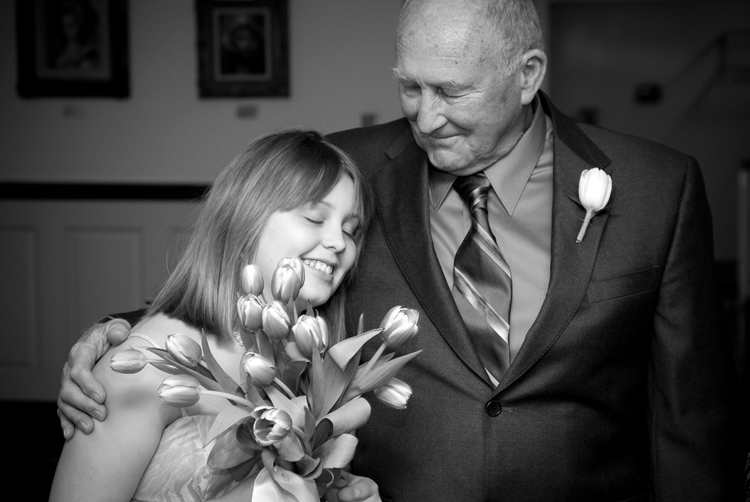
If you don’t want to read the rest of the post, with all the ‘splainin’, here’s the short version: For the most flattering headshots, shoot with a focal length somewhere between 85-100mm. That’s it.
For the longer version, here we go… **big stretch**deep breath**and, go…
When it comes to portraiture, which focal length to choose depends on the type of shot you’ll be taking. If you plan on taking a tight, head-and-shoulders shot you will get the most pleasing results shooting somewhere in the 85-100mm range. Why is this? Can’t we get the same tight shot with a 50mm by just moving in closer? Well, yes and no. With a wider lens, you can move physically closer to your subject and achieve a similar composition. However, shooting in this manner will distort your subject’s face. The closer you get to your subject, the closer they are to the curvature of the front element of the lens. This will cause the subject’s nose/face to bulge, looking unnatural. Shooting between 85-100mm, we get the same tight composition, but we are further away from the subject. More importantly, the subject is far away from the curvature of the front element of the lens. This keeps the subject’s nose /face from bulging, and therefore looking natural.
What about shooting with a focal length longer than 100mm? Can’t we use a 300mm and just move back? Again, yes and no. Shooting with a lens longer than 100mm you begin to have the opposite effect. The more we zoom in on something the more it compresses the image. So, the further past 100mm you get, the more compressed your subject’s nose/face becomes, looking flatter than it should.
To put it another way, shooting with a focal length between 85mm and 100mm eliminates the unflattering facial distortion wide-angle lenses are notorious for, while avoiding the compression long telephoto lenses give.
So which is it? 85mm or 100mm? There’s a massive debate over that one. In my opinion, it doesn’t really matter. In my honest opinion, anywhere between 85mm and 100mm is pleasing for close-up portraits. What about using a prime lens or a zoom? The nice thing about zooms that incorporate the 85-100mm range is the flexibility to pick 85mm, 100mm or anywhere in between. Plus, you don’t have to move your tripod or model each time you recompose the shot. On the other hand, Prime lenses tend to be sharper than zooms, but you loose the flexibility. So, pick your poison.
Most entry-level SLRs come with an 18-55mm lens. If this is all you can afford, then simply stay away from tight headshots to keep from distorting your subjects. If, however, you need to shoot tight headshots (to fulfill your vision), and you can afford it (without going into debt), then consider another lens. The complimentary lens you can pick up for a modest investment is the 55-200mm for Nikon, and the 55-250mm for Canon. These are relatively inexpensive and incorporate the 85-100mm focal length.
Again, this is all applies to tight, head-and-shoulder shots. Anything other type of portrait (3/4 length, full length, wide environmental, etc), you can use just about any focal length you want. For all of you out there confused about focal lengths, I hope things are a bit more clear.
Now, go out and shoot something!

Todd, most of my work has been done with a 50mm so far, but I will be purchasing a 85mm soon. I do have a question, does whether or not the camera is full frame or cropped sensor play a role? What I mean is, are we only talking about the focal length of the lens causing the distortion or does the added focal length of a cropped sensor affect the image. Let me give you an example to clarify... 50 mm on a cropped sensor is more like 80mm, does that mean less distortion or should I still go for an 85mm (actually more like 136) to get less distortion or will the 50mm do?
ReplyDeleteExcellent question Bradley! Glad you brought it up. More than that, I'm glad you're thinking! It does depend on full or cropped sensor. Remember, it isn't so much the actual mm of the lens as it is the subject-to-lens distance. The closer you get to your subject physically, the closer they are to the curvature of the front element of the lens. Which is what causes the subject’s nose/face to bulge, looking unnatural. So, you are right that on your camera a 50mm is getting your subject further away from that front element. Thus, the distortion will be diminished.
ReplyDeleteAs for the telephoto side of things,I usually don't worry about the compression it gives. Its the bulging of facial features from wide angel that I consider problematic and unacceptable. And really, shooting at a 135mm equivalent will be a very minimal amount of compression, and still excellent for portraiture. One thing you can do to see the difference is take a tight headshot with the 50mm. Then take the exact same composed headshot with the 85mm. When viewed side by side, you will see the difference.
At any rate, for your situation, the 50mm will continue to be a great lens to utilize , especially for 3/4 length and environmental portraiture. AND the 85mm would be another stellar lens to have in your arsenal, especially for tighter shots.